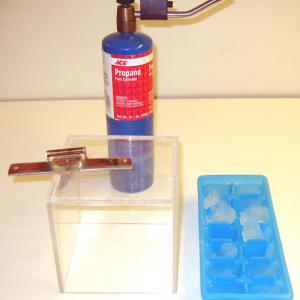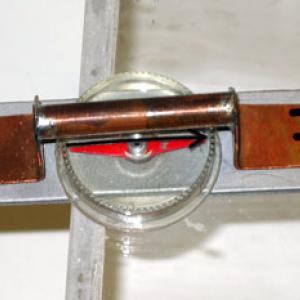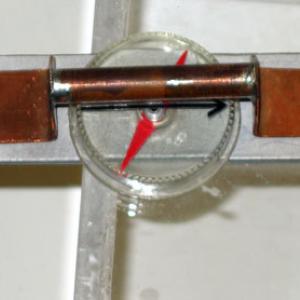College of Liberal Arts & Sciences
5E50.19 - Seebeck Effect - Thermoelectricity
There are three different systems to use for this demonstration. The Aluminum/Copper or Nickel/Copper systems seem to work best. An Iron/Copper system is also available.
Place the Aluminum/Copper system on the Plexiglas box with one end hanging over the edge of the box. Place the compass into the center of the apparatus and then line both the compass and the apparatus up on the Earths north-south line. Heat one end of the apparatus with the propane torch while cooling the other end with some ice. The compass should deflect 30 to 45 degrees from the initial position as the heat is applied.
Caution: Do not apply the heat in such a way or for a continued duration so as you melt the plastic compass.
The "Thermoelectric Series" is a set of elements that can be used to build a Seebeck device. The farther apart the two elements you are using are on the table, the better the thermoelectric effect.
- Silicon
- Bismuth
- Nickel
- Cobalt
- Palladium
- Platinum
- Uranium
- Copper
- Manganese
- Titanium
- Mercury
- Lead
- Tin
- Chromium
- Molybdenum
- Iridium
- Gold
- Silver
- Aluminum
- Zinc
- Tungsten
- Cadmium
- Iron
- Arsenic
- Tellurium
- Germanium
- Thomas B. Greenslade Jr., "A Quick Thermoelectricity Demonstration", TPT, Vol. 44, # 1, Jan. 2006, p. 50.
- Barbara Goss Levi, "Simple Compound Manifest Record-High Thermoelectric Performance", Physics Today, June 2014, p. 14.
- RMW, "Heating and Cooling with Electron Spins", Physics Today, May 2012, p. 19.
- George M. Hopkins, "Thermo-Electric Current", Experimental Science, p. 422.
- Caroline Delbert, Courtney Linder, "Scientists Just Figured Out How to Turn Your Body Into a Battery", Popular Mechanics, July/Aug. 2021, p. 22.
- Yaakov Kraftmakher, "5.8, Thermoelectric Phenomena", Experiments and Demonstrations in Physics, ISBN 981-256-602-3, p. 349.
- "Another Thermo Battery", The Boy Scientist, p. 98.
- W. Bolton, "Thermoelectricity", Book 4 - Electricity, Physics Experiments and Projects, 1968, p. 34-35.
Disclaimer: These demonstrations are provided only for illustrative use by persons affiliated with The University of Iowa and only under the direction of a trained instructor or physicist. The University of Iowa is not responsible for demonstrations performed by those using their own equipment or who choose to use this reference material for their own purpose. The demonstrations included here are within the public domain and can be found in materials contained in libraries, bookstores, and through electronic sources. Performing all or any portion of any of these demonstrations, with or without revisions not depicted here entails inherent risks. These risks include, without limitation, bodily injury (and possibly death), including risks to health that may be temporary or permanent and that may exacerbate a pre-existing medical condition; and property loss or damage. Anyone performing any part of these demonstrations, even with revisions, knowingly and voluntarily assumes all risks associated with them.


